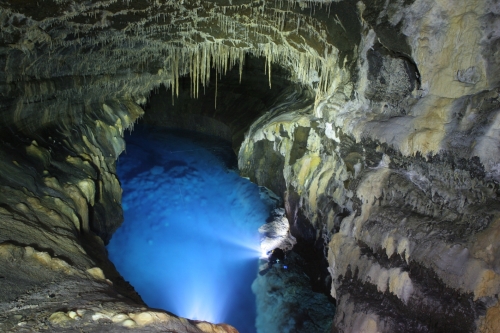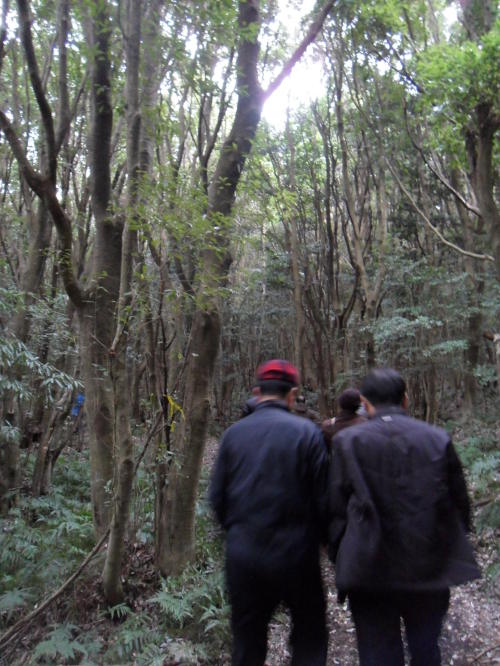A maintenance worker planted an electricity pole in Woljeong-ri, Jeju Island in 2005. The next day, the pole was gone.
Upon close inspection, he discovered that the pole had sunk into a deep hole with seemingly no bottom.
That is how Yongcheon Cave was accidently revealed to the world, after lava from the volcanic eruption on Jeju Island made a series of lava caves, called “Geomun Oreum Lava Tube System,” flowing from the east side of Mount Halla to the sea shore more than 200,000 years ago.
Yongcheon Cave is one of the major natural wonders of Jeju that is full of unique character, contributing to the island’s bid to become one of the “New7Wonders of Nature” on Nov. 11. The volcanic island is one of the 28 final candidates.
 |
The lake inside Yongcheon Cave on Jeju Island. (The National Committee for Jeju New7Wonders of Nature) |
The lava and limestone cave is not open to the general public, except for a few researchers.
However, reporters had a rare opportunity to enter the cave last week after attending the voting campaign ceremony hosted by the National Committee for Jeju New7Wonders of Nature.
Through a small hole, a 10-meter steel ladder leads down to the bottom of Yongcheon Cave. Outside was minus one degree Celsius but inside the cave was about 17 degrees. Near the hole outside, you could feel the warm air blowing up and out from inside.
From the entrance, the “upperstream” of the cave is about 600 meters long and the “downstream” is about 2.4 kilometers long. At the end of the downstream, there is an 800-meter-long lake where the first 200 meters is half-water, half-cave, and the remaining 600 meters is full of water. The end of the lake is blocked from the sea by sand.
“This cave has many peculiar things that are not seen in any other cave in the world. If it hadn’t been discovered in 2005, it would have been difficult for Jeju Island to be inscribed on the UNESCO World Natural Heritage list in 2007,” said Jeon Yong-mun, a research scientist of the World Natural Heritage management bureau of Jeju Special Self-Governing Province.
“What we’re seeing today is only about one thousandth of the cave,” he said.
The government research team conducted carbon dating analysis of relics discovered inside the cave and found that the cave had human contact about 1,300-1,400 years ago ― in the seventh or eighth century when the Unified Silla Kingdom ruled the peninsula.
The relics collected in various places from the cave floor include charcoal, earthenware vessels, abalone and clam shells as well as bones of rats, wild boar and weasels. And the dating analysis results were all similar, pointing to that period.
The charcoal is thought to have come from the use of torch lights and some of the charcoal was still found on the cave floor during the press visit.
“We may speculate that people entered the cave either for dwelling or for religious services. But we haven’t figured it out yet,” Jeon said.
Another unique feature of the cave is its white floor and ceiling, caused by lime, while other lava caves of the Geomun Oreum lava tube system have black floors and ceilings.
You can see many stalactites hanging down from the ceiling ― some of them formed around the roots of trees growing on the outside surface of the cave.
As there are more trees in the direction of the upperstream outside, there are more stalactites in that direction.
The stalactites are of varied lengths but most are longer than 1.5 meters.
According to Jeon, stalactites grow about 3 milimeters every 100 years.
The reason Yongcheon Cave has lime is that 90 percent of the sand carried by the wind from the nearby Gimnyeong beach to Yeongcheon side contained clam shells. Those clam shells melt in the acid rain that filters through the cave. As the water evaporates, only the lime is left.
Reporters were not able to go deep enough to see the lake but were told that there are three unidentified fish species, which add a further unique quality to Yongcheon Cave.
The 4-7 centimeter fish have a blunt mouth, a flat head and thin body, and live at the sandy bottom of the lake, according to the National Committee for Jeju New7Wonders of Nature.
The fish are similar to gobies seen in Jeju’s coastal waters but it was the first time they were found in a cave environment in Korea.
Gotjawal forest, undisturbed by humans
Another unique feature of Jeju Island are Gotjawal forests. When it is cold and windy in the winter, Gotjawal Forest remains warm.
“Gotjawal,” named by Jeju locals, refers to a dense forest of evergreen plants, trees, rocks and bushes.
A Gotjawal forest is formed on the mid-slope of Mount Halla covering the rocky area on the land. There are four Gotjawal forests; Hangyeong-Indeok in the west, Aewol in northwest, Jocheon-Sunheul in northeast and Gujwa-Seongsan in the east.
Sunheul Gotjawal Forest, also known as Evergreen Forest, 4 kilometers long in a north-south direction and 8 kilometers in an east-west direction.
 |
Reporters walk in the Sunheul Gotjawal Forest on Jeju Island on Jan. 13.(Kim Yoon-mi/The Korea Herald) |
Gotjawal forests have many interesting features. One of them is that Gotjawal is home to wild animals looking to stay warm in the cold winter.
In the forest, you can see some small caves naturally formed through the cracks of lava rocks.
“There are about 26 small caves in this forest. Because it is always warm inside the cave, animals including deer take shelter there when it snows heavily,” a tour guide said.
It is also home to several endangered species of plants and animals.
Another important feature is that Gotjawal Forest is the island’s second largest groundwater aquifer, next to Mount Halla, helping people drink water along the coastline of the island.
By Kim Yoon-mi (
yoonmi@heraldcorp.com)









